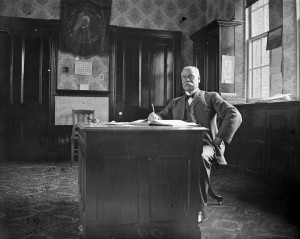Given the strong connection in popular culture between testosterone and manliness, it is unsurprising that men are concerned by low testosterone.
In the body, this hormone plays a role in the development and maintenance of common male characteristics such as muscle growth, strength, and facial and body hair.
Testosterone levels peak in men during adolescence, and gradually decline starting around age 30. This decrease — along with physical, sexual and emotional symptoms related to aging — have been labeled by some medical professionals as male menopause.
Menopause is a term first applied to the stage of a woman’s life — between 45 and 55 years of age — when menstruation becomes less frequent, and eventually stops. During this time, estrogen and progesterone levels decrease, and women experience symptoms such as hot flashes, difficulty sleeping and night sweats. Some physicians feel that men undergo a similar process of hormonal changes and associated symptoms.
The topic of male menopause was first mentioned in the medical community in the 1930’s, but gained traction with physicians and the public during the late 1990’s.
Common Symptoms of Male Menopause
- Emotional: decreased motivation or self-confidence; depression; difficulty concentrating or remembering; sleep problems
- Physical: decreased muscle mass, strength and endurance; increased body fat; smaller testes; development of breast tissue
- Sexual: erectile dysfunction; decreased sexual desire; fewer spontaneous erections.
Does Male Menopause Really Exist?
 Medical professionals continue to debate whether male menopause exists, and how to accurately diagnose it.
Medical professionals continue to debate whether male menopause exists, and how to accurately diagnose it.
To avoid confusion, some physicians use other terms, such as andropause, testosterone deficiency or late-onset hypogonadism. These all refer to the symptoms and hormonal changes associated with male menopause.
Unlike the relatively rapid hormonal changes in females, testosterone levels in men decrease over decades, about 1% each year between the ages of 40 and 70. This adds up to a 50% reduction in testosterone by age 70.
Some physicians believe that male menopause exists because symptoms are relieved when men are given additional testosterone, such as in gels or injections. This type of therapy, however, does not work for all men. Complicating matters, other diseases and prescription medications can give rise to the symptoms of male menopause.
Testosterone levels in men decrease 50% by age 70.
How Do I Know If I Have Male Menopause?
Male menopause can only be diagnosed with a physical exam and blood tests. In addition to measuring your testosterone levels, your doctor will run diagnostic tests to rule out conditions — such as diabetes and heart disease — that may cause similar symptoms.
Low testosterone does not mean that you have male menopause. Some men with low levels testosterone do not show any symptoms, and some men with symptoms actually have “normal” levels.
As physicians conduct additional scientific studies, the criteria for diagnosing male menopause–or late-onset hypogonadism–are refined. A recent study found that using a combination of testosterone levels and the presence of sexual dysfunction provided better results.
With this method, the researchers found that only 2.1% of men between the ages of 40 and 70 have late-onset hypogonadism, much lower than if determined using testosterone levels alone.
2.1% of men between the ages of 40 and 70 have late-onset hypogonadism, or male menopause.
What Can I Do About Male Menopause?
- Consult your doctor. Your doctor will assess your symptoms, measure your testosterone, and rule out other underlying causes, such as medications, heart disease or diabetes.
- Eat healthy and exercise regularly. A healthy diet and regular exercise both increase energy level and improve mood. Exercise also builds muscle mass and increases strength.
- Seek help if depressed. Depression may not be related to low testosterone levels. In men, depression shows up as irritability, feeling withdrawn or isolated, overworking, or drinking too much alcohol.
- Consider testosterone-replacement therapy. Supplemental testosterone has been shown to improve erectile function and sex drive in some men. This type of therapy has several risks–including stimulating the growth of prostate cancer and increasing the risk of heart disease.
More than 2.6 million prescriptions for testosterone products were written in 2008, a 384% increase since 2002.
References
- Nazem Bassil, Saad Alkaade and John E Morley. “The benefits and risks of testosterone replacement therapy: a review,” Therapeutics and Clinical Risk Management 5(2009): 427–448.
- Enrique R. Boloña et al., “Testosterone Use in Men With Sexual Dysfunction: A Systematic Review and Meta-analysis of Randomized Placebo-Controlled Trials,” Mayo Clinic Proceedings 82(2007): 20-28.
- Dr. Weil. “Is There a Male Menopause?” Accessed November 10, 2011.
- FDA: “Androgel (testosterone) BPCA Drug Use Review.” Accessed November 10, 2011.
- Henry A. Feldman et al., “Age Trends in the Level of Serum Testosterone and Other Hormones in Middle-Aged Men: Longitudinal Results from the Massachusetts Male Aging Study,” The Journal of Clinical Endocrinology & Metabolism 87(2002): 2589-98.
- Huffington Post. “Male Menopause: The Effects of Dwindling Testosterone.” Accessed November 10, 2011.
- Ilpo Huhtaniemi and Gianni Forti et al., “Male late-onset hypogonadism: pathogenesis, diagnosis and treatment,” Nature Reviews Urology 8(2011): 335-44.
- Mayo Clinic. “Male menopause: Myth or reality?” Accessed November 10, 2011.
- WomensHealth.gov. “Menopause.” Accessed November 22, 2018.
- Elizabeth Siegel Watkins, “The Medicalisation of Male Menopause in America,” Social History of Medicine 20(2007): 369-38.
- Frederick C.W. Wu et al., “Identification of Late-Onset Hypogonadism in Middle-Aged and Elderly Men,” New England Journal of Medicine 363(2010): 123-35.
__________
Originally published on Healthism.
Photo: Library and Archives Canada


